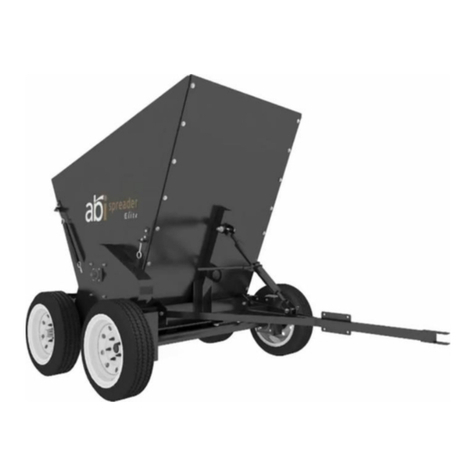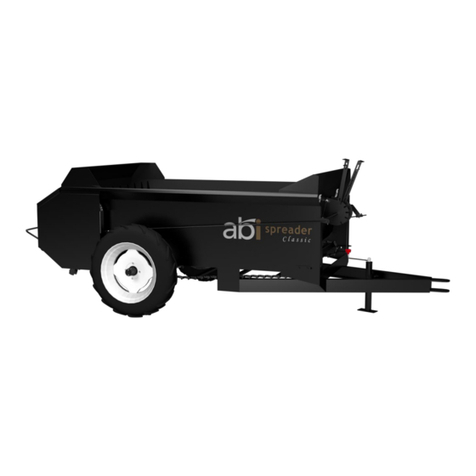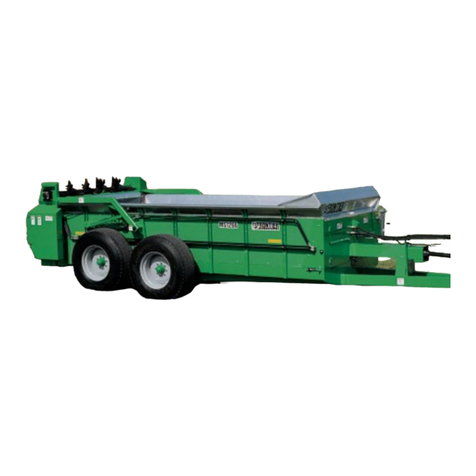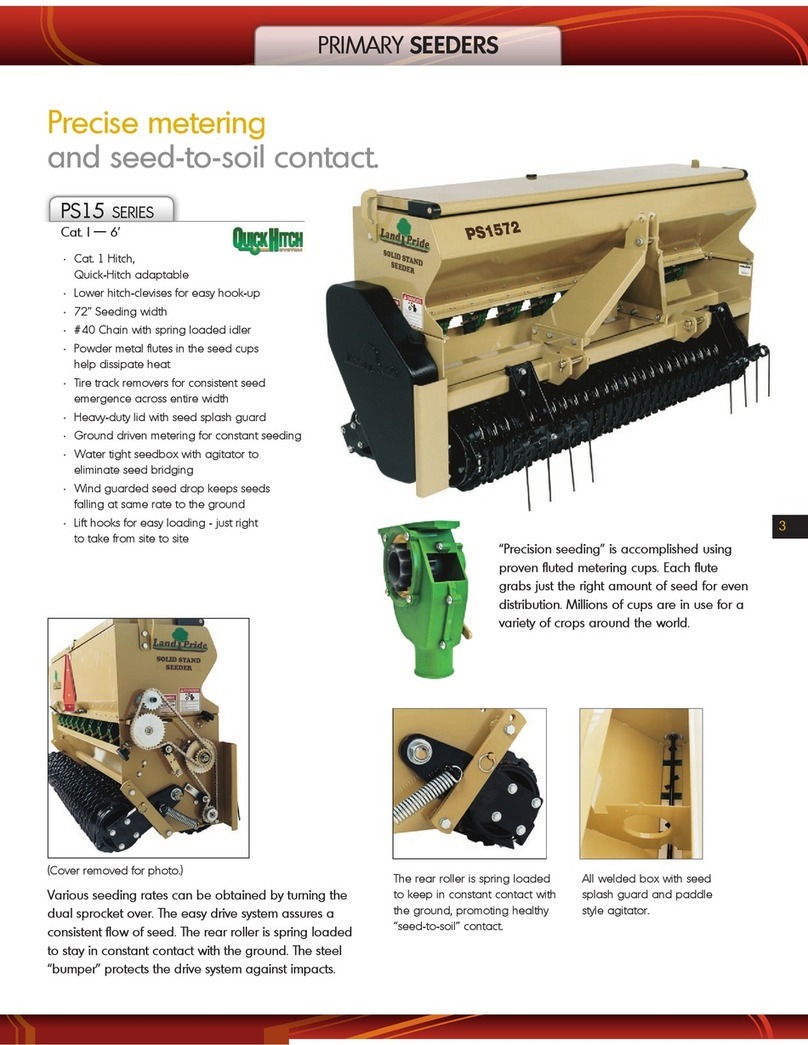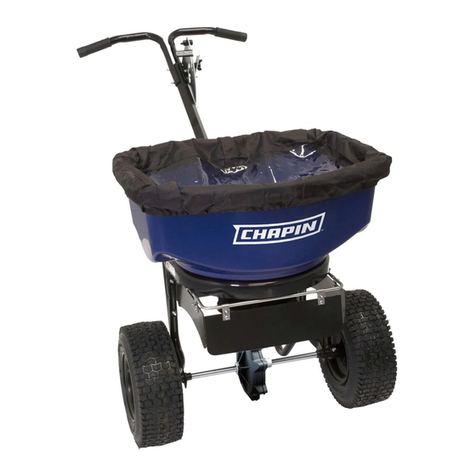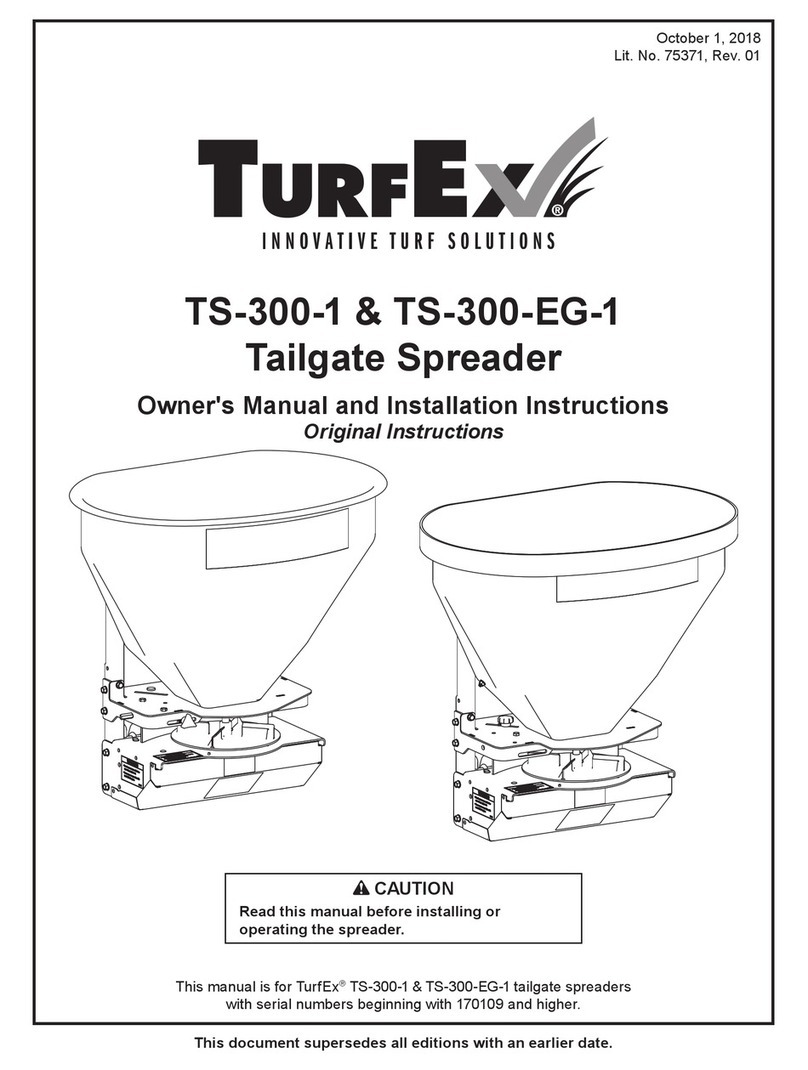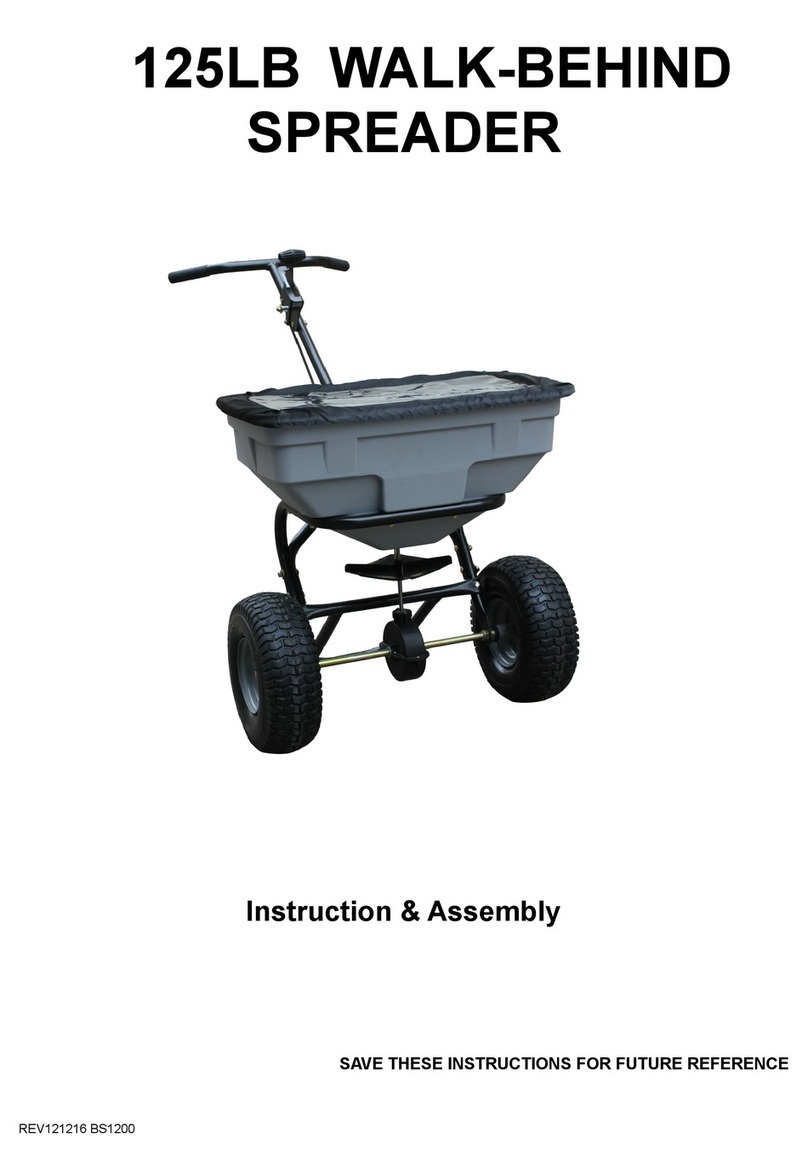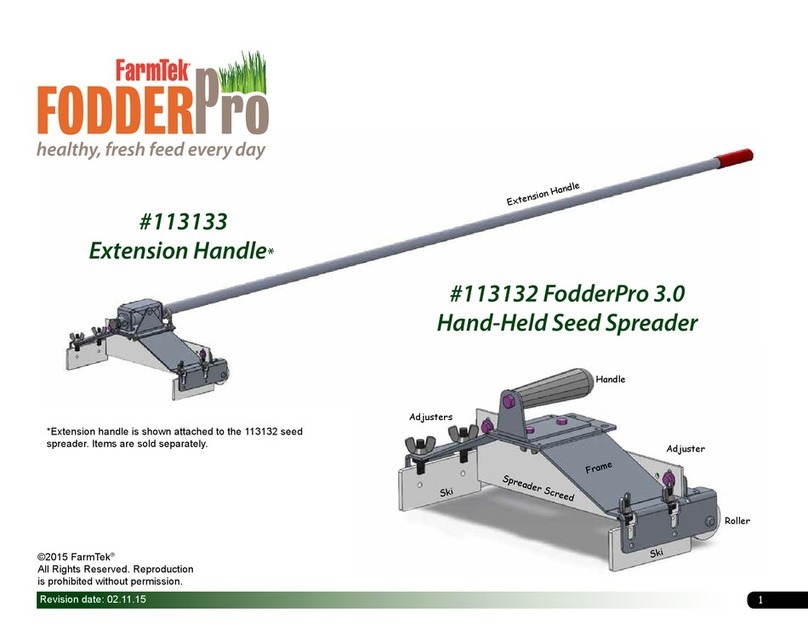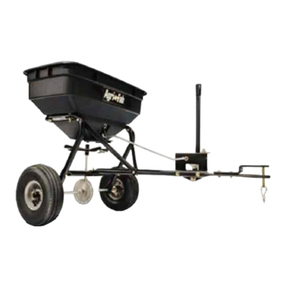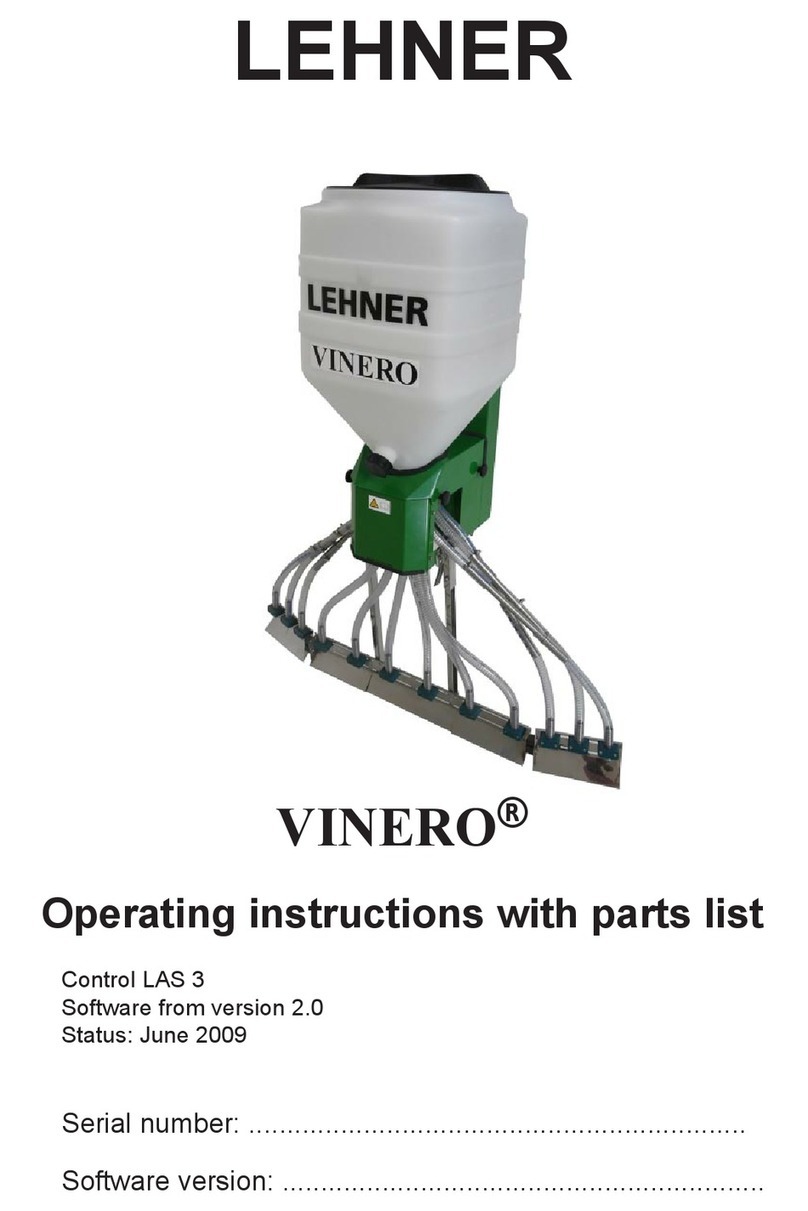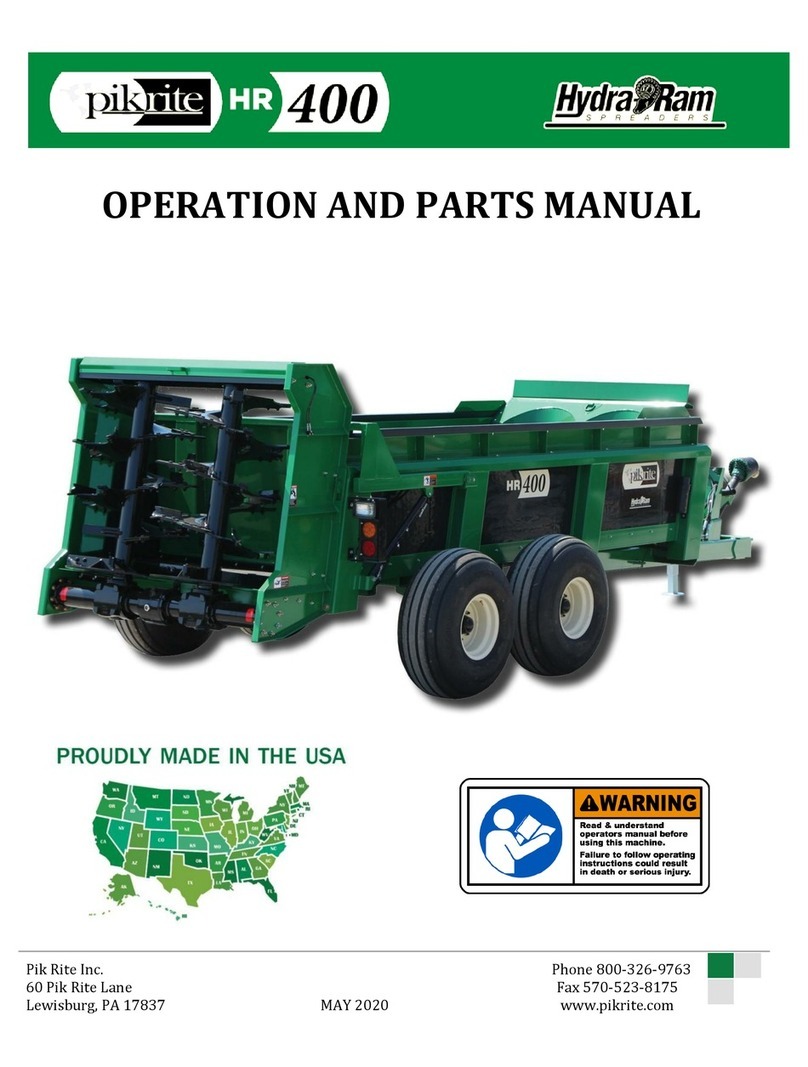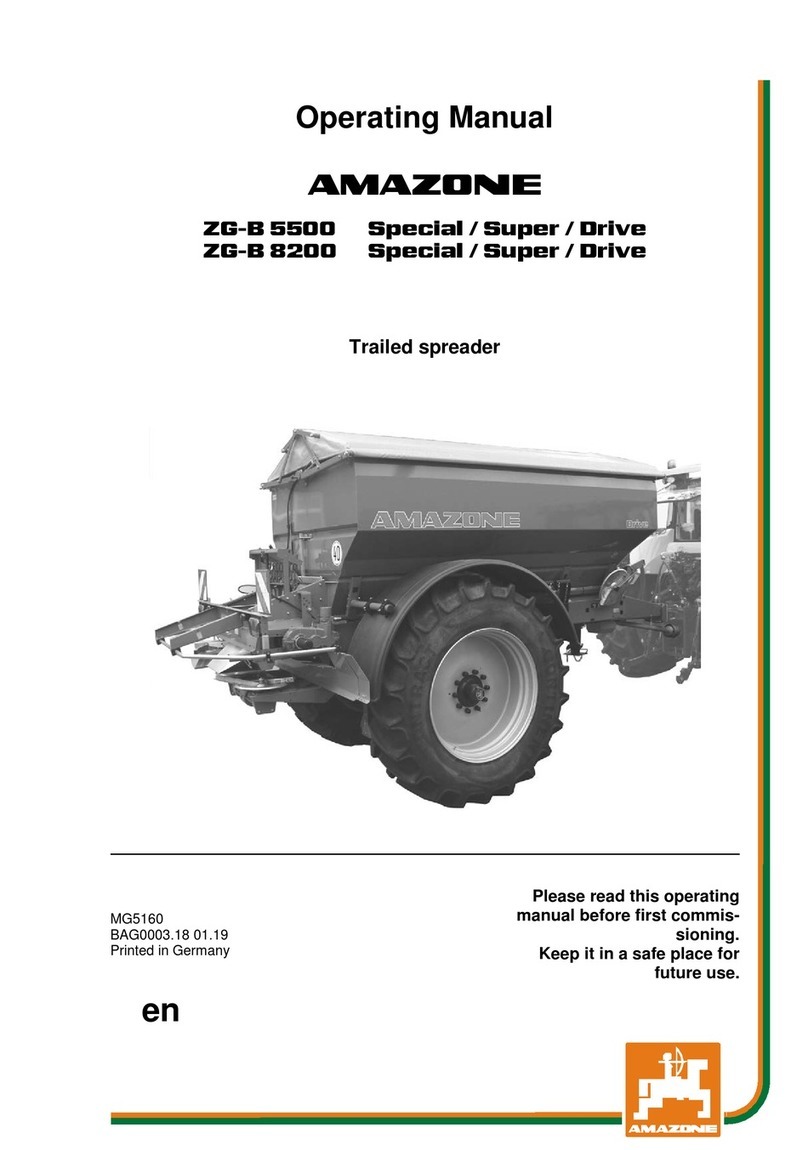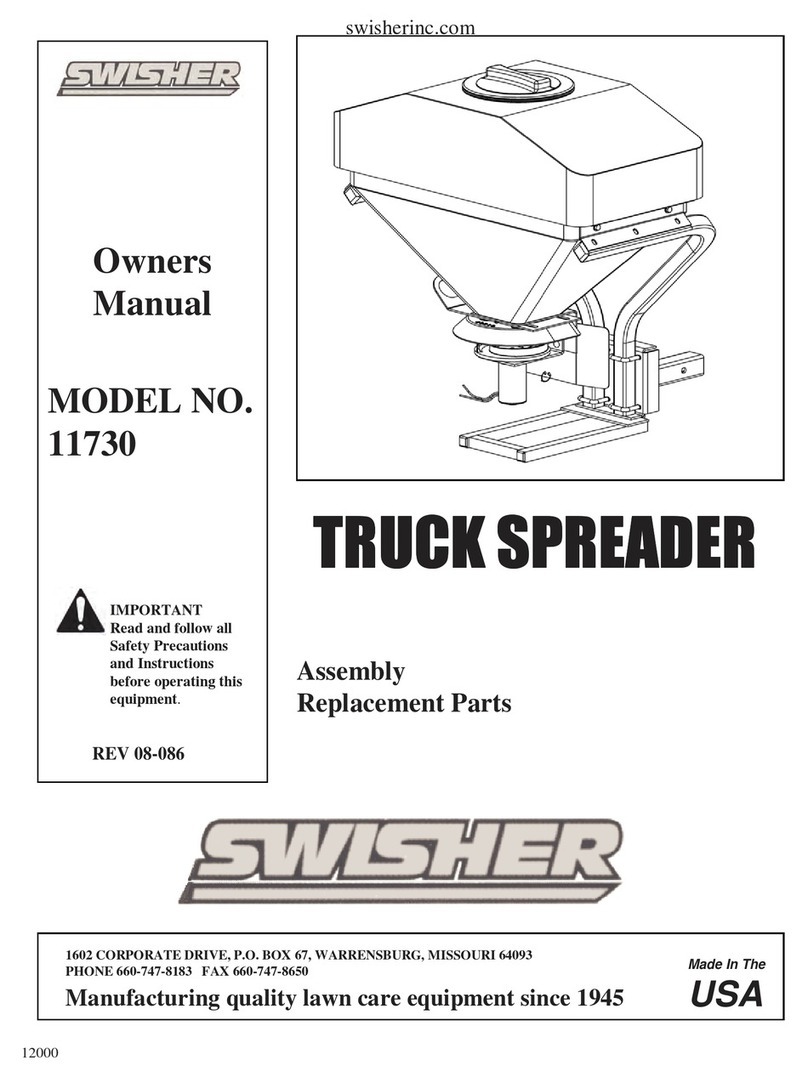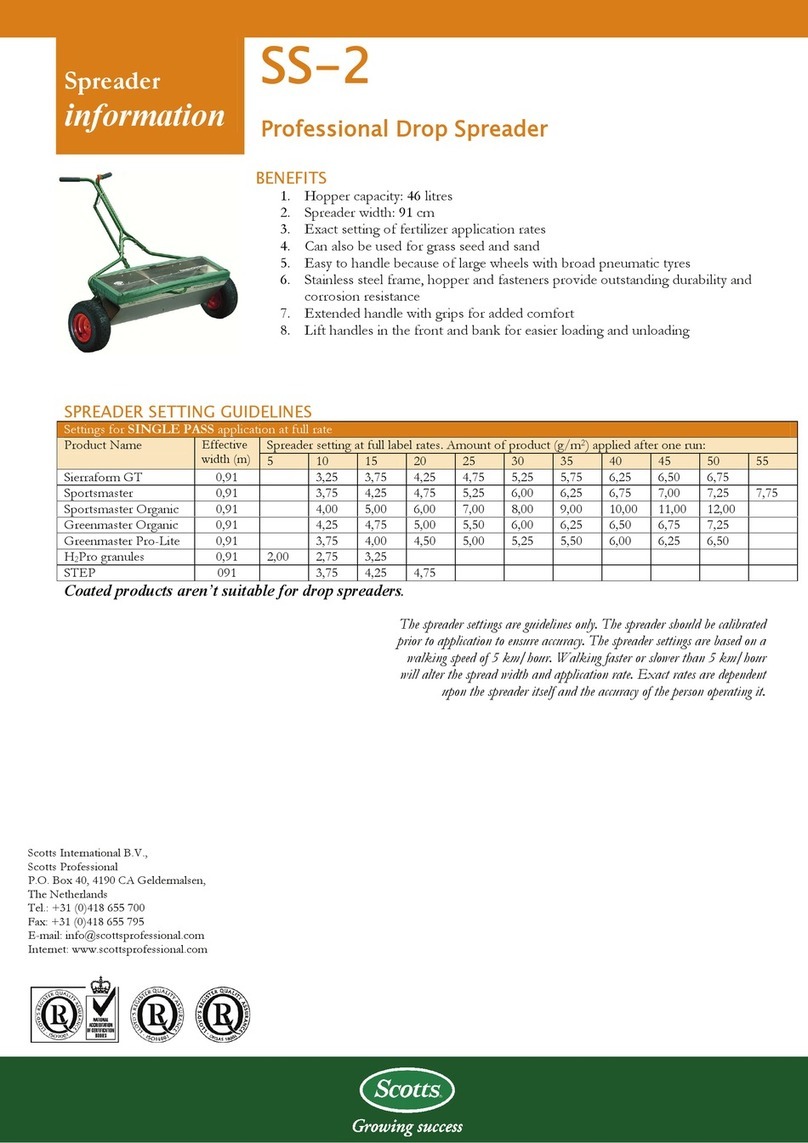abi Classic Spreader 25 User manual

Owner’s Manual
25/50/65/85 Cubic Foot Ground Drive Models
© Copyright 2017 ABI Attachments, Inc.
1

Index
Safety Precautions…………………………………………………………... 4
Features………………………………………………………………………..6
Specifications..………………………………………………………………...9
Quick Start Guide…………………………………………………………….11
Usage………………………………………………………………………….13
Maintenance……………………………………………………………….....18
Litter Pan Installation………………………………………………………...20
End Gate Installation………………………………………………………...22
Parts…………………………………………………………………………...23
Model and Serial Number
Attached to the frame is an ID plate showing the serial number. Record your implement
information and serial number in the space provided below. ABI will use this information to give
you prompt, efficient service when you order parts.
Size: ___________________________________
Serial number: ___________________________
Invoice number: __________________________
Purchaser’s name: ________________________
© Copyright 2017 ABI Attachments, Inc.
2

Thank you!
On behalf of the ABI family, we would like to thank you for your recent purchase of your ABI
Classic Spreader. Our company’s goal is to provide you with innovative, quality tools as well as
first rate customer service.
This setup guide will help you to get your new ABI Classic Spreader off the delivery pallet and
into use. Once you have put your ABI Classic Spreader to work, if you have any questions,
please feel free to contact our support department at 855.211.0598.
To the Operator:
The information presented in this manual will prepare you to operate the ABI Classic Spreader
in a safe and knowledgeable manner. Operating the ABI Classic Spreader in a proper manner
will provide a safer working environment and create a more efficient result. Read this manual
fully and understand the entire manual prior to setup, operation, adjusting, performing
maintenance, or storing the ABI Classic Spreader. This manual contains information that will
allow you to get years of dependable performance from your spreader.
This manual will provide you with information on safely operating and maintaining the ABI
Classic Spreader. Operating the ABI Classic Spreader outside of the stated safety and
operations guidelines may result in injury to the operator and equipment, or void the warranty.
The information provided in this manual was current at the time of printing. Variations may be
present as ABI Attachments, Inc. continues to improve and upgrade the ABI Classic Spreader
for future use. ABI Attachments, Inc. reserves the right to implement engineering and design
changes to the ABI Classic Spreader as may be necessary without prior notification.
© Copyright 2017 ABI Attachments, Inc.
3

Safety Precautions
Please exercise caution at all times when setting up, operation, or performing
maintenance on the ABI Classic Spreader. Remember, any piece of equipment like the
ABI Classic Spreader can cause injury/damage if operated improperly, or if the user does
not understand how to operate the equipment. Exercise caution at all times with using
the ABI Classic Spreader.
● Never permit any person to ride or board the ABI Classic Spreader at any time. NEVER
ALLOW RIDERS ON THE ABI CLASSIC SPREADER!
● Ensure the implement is properly mounted, adjusted and in good operating condition.
● Be sure the tractor is in neutral before starting the engine.
● Use care and maintain minimum ground speed when operating the ABI Classic Spreader
on a hillside or when operating close to ditches, fences, or water sources.
● Personal protection equipment including safety glasses, safety shoes, and gloves are
recommended during assembly, installation, operation, adjustment, maintaining and/or
repairing the implement.
● Be sure that no one is near the machine prior to engaging or while the machine is
working.
● Operate the ABI Classic Spreader in the daylight or under good artificial light. Operator
should always be able to clearly see where they are going.
● Be alert for hidden hazards. Always operate the ABI Classic Spreader with caution over
work environments that may have buried obstacles.
● Stay clear of all moving parts. Keep all limbs clear of attachments when making
adjustments with all hydraulically operated attachments.
● Use caution when operating the ABI Classic Spreader in icy, wet, or snowy conditions.
● Do not use the ABI Classic Spreader on highways or public thoroughfares. The ABI
Classic Spreader is designed for off road use only.
● Operate the implement only with a tractor equipped with an approved
Roll-Over-Protective-System (ROPS). Always wear your seatbelt. Serious injury or even
death could result from falling off the tractor.
● Always follow your tractor manufacturer’s rules for safe operation of the tractor and for
proper procedures for attaching and disconnecting attachments. Contact your local
tractor dealership for an owner’s manual for any questions related to the safe operation
of the tractor.
● The use of this equipment is subject to certain hazards which cannot be prevented by
mechanical means or product design. All operators of this equipment must read and
understand this manual, paying particular attention to safety and operating instructions,
prior to using.
● Do not operate the tractor/ATV and implement when you are tired, sick, or when using
medication.
© Copyright 2017 ABI Attachments, Inc.
4

● Keep all helpers and bystanders at least 50 feet away from the machine. Only properly
trained people should operate this machine.
● The majority of accidents involve operators being knocked off the tractor by low hanging
limbs and then being run over by the implement. Accidents are most likely to occur with
machines that are loaned or rented to someone who has not read the operator’s manual
and is not familiar with the implement.
● Always stop the tractor, set brake, shut off the tractor engine, remove the ignition key,
lower implement to the ground, and allow rotating parts to come to a complete stop
before dismounting tractor. Never leave equipment unattended with the tractor running.
● Never place hands or feet under implement with tractor engine running or before you are
sure all motion has stopped. Stay clear of all moving parts.
● Do not reach or place yourself under equipment until it is blocked securely.
● Never place hands or feet under implement with tractor engine running or before you are
sure all motion has stopped. Stay clear of all moving parts.
● Keep hands, feet, hair, and clothing away from moving parts.
● Never operate tractor and implement under trees with low hanging limbs. Operators can
be knocked off the tractor and then run over by implement.
● Reduce speed on slopes and sharp turns to minimize tipping or loss of control. Be
careful when changing directions on slopes.
● Inspect the entire machine periodically. Look for loose fasteners, worn or broken parts,
and leaky or loose fittings.
● Pass diagonally through sharp dips and avoid sharp drops to prevent “hanging up”
tractor and implement.
● Avoid sudden starts and stops while traveling up or downhill.
● Always use down slopes; never across the face. Avoid operation on steep slopes. Slow
down on sharp turns and slopes to prevent tipping and/or loss of control.
Use caution when operating the ABI Classic Spreader. Using the ABI Classic Spreader outside
of stated safety and operations guidelines may result in injury to operator or others, property
damage, or a void of warranty.
CAUTION: Our machines are designed considering safety as the most important aspect and are
the safest available in today’s market. Unfortunately, human carelessness can override the safety
features built into our machines. Injury prevention and work safety, aside from the features on our
tools, are very much due to the responsible use of the equipment. It must always be operated
prudently following with great care, the safety instructions laid out in this manual.
© Copyright 2017 ABI Attachments, Inc.
5

Information on the ABI Classic Spreader
⅓ Heavier than most competitor’s
When it comes to equipment made of steel; weight is a good thing. The heavier the manure
spreader, the more high density steel is being used. Using higher density steel means the
manure spreader will last longer and perform better. Weight is a quality metric you can feel.
Shredded output
Shredding the material has a number of advantages. It exposes more of the manure to sunlight,
which reduces eggs/fly larva and allows manure to decompose far more quickly than
non-shredded material. It also enables the manure to decompose quickly to encourage a
healthy pasture and greatly reduces the amount of time between spreading and horses grazing
again on the pasture.
Variable flow control
Variable flow control enable ts the operator to apply just the right amount of material to the
ground. This ensures proper application rates of material to maximize its nutritional value, while
also minimizing waste and reducing nitrogen burn to vegetation. All ABI Classic manure
spreaders feature the ability to control the flow rate of manure being applied to the ground. Both
the PTO and ground drive manure spreaders have 4 different speed settings that are controlled
by the lever (ground drive models) or a pull rope (PTO models). Flow control is accomplished by
speeding up or slowing down the apron chain (conveyor) that feeds the manure to the back
beaters. You now have the choice of emptying the spreader as fast as possible or applying
controlled amounts of manure.
The combination of shredded output, controlled spread, and variable flow control makes the ABI
Classic Spreader one of the most eco-friendly spreaders on the market.
All welded COR-TEN steel construction
All ABI Classic Spreaders are fully welded for a long life and made of COR-TEN steel to resist
rust and corrosion. Unlike standard mild steel used by competitors, COR-TEN is “weathering”
steel originally engineered as a corrosion resistant steel for the construction industry. This steel
may be exposed to the elements, even unpainted, and not rust of many years (ABI spreaders
are painted for black for cosmetic reasons, however). Most competitors bolt together many
components of of their spreaders. ABI Classic Spreaders are fully welded to take on the most
punishing situations for many years.
© Copyright 2017 ABI Attachments, Inc.
6

Unique chain engagement mechanism
To virtually eliminate drive chain slip when engaging or disengaging the drive chain, ABI Classic
Spreaders utilize a mechanism that gradually lifts the chain off the sprocket one tooth at at a
time to disengage. To re-engage, this mechanism then gently lays the chain back on the
sprocket seating the chain on each tooth of the sprocket. This process keeps the chain and
sprocket in alignment and reduces the possibility the chain will slip or fall off the sprocket
causing unneeded repair, wear and tear, and breakage. This mechanism is controlled by the
front right operating lever (as you are looking toward the rear of the spreader). Most competitor
engagement mechanisms do not keep the chain and sprocket in alignment and do not assist in
the reseating of the chain on each sprocket tooth.
Dual wheel ground drive with ratcheting hubs
Unlike many ground drive systems, the ABI Classic Spreader incorporates a sophisticated
system that enables better ground traction and provides constant power to the apron chain and
beater bars. As you look from the rear to the front of the spreader, the right wheel primarily
drives the apron chain (conveyor) and the left wheel primarily drives the beater bars.
Additionally, both wheels act in unison to maximize traction and prevent the apron and beater
from running at different speeds. This eliminates slipping and binding of the moving parts and
reduces wear and tear and breakages to the chains, sprockets, and gears. The hubs on the ABI
Classic Spreader have a ratcheting override when moving in reverse or taking sharp corners.
This allows the wheels to move independently when taking sharp corners or in reverse, even
while engaged.
Shredder beaters
Unlike most spreaders that only use one beater bar to spread material, the ABI Classic
Spreader uses 2 or 3 beaters depending on the unit size. On the 25, 50, and 65 cu. ft. models,
the spreader has one beater bar that shreds the manure and bedding into smaller pieces before
the manure is passed through to the wide spread paddles and thrown from the spreader. This
additional shredding process breaks down the material for quick decomposition which promotes
a healthy pasture.
Coal tar epoxy box liner and tongue & groove poly floor
To further prevent corrosion and rust, the inside of the box is sprayed with a coal tar epoxy liner.
This box liner is not a traditional truck bed plastic insert liner that can cause corrosion
underneath and it is not a soft rubbery material that can tear. This box liner is ideally suited for
the unique demands of a manure spreader. Coal tar epoxy offers great “flex”, so it is perfectly
suited to expand and contract with climate and can handle the abrasion and acidity of manure
flowing through the spreader. Coal tar epoxies are famous for protection from moisture and are
commonly used on garage floors, underground pipelines/tanks, and even the hulls of barges.
© Copyright 2017 ABI Attachments, Inc.
7

The floor of the ABI Classic Spreader is constructed of a tongue and groove poly lumber, so it
will never rot or rust. The tongue and groove construction prohibits the individual poly boards
that make up the floor from warping, which would cause the apron chain to get caught and bind
on the flooring. This is a premium maintenance free flooring that will last and comes with a
limited lifetime warranty.
“5 Point” Corrosion and Rust Resistance
Corrosion and rust resistance is one of the top concerns customers have in buying manure
spreaders. ABI does not take this concern lightly. To ensure our spreaders will last for many
years to come, we have implemented a suite of measures to prevent against corrosion and rust.
1. We start with corrosion resistant COR-TEN Steel.
2. All steel components are sandblasted before painting. This cleans the impurities off the
steel and opens the pores to absorb the paint for the best bond.
3. Rust-Oleum “Stops-Rust” paint is applied. This paint is easy to repair and touch up.
Unlike powder coating, moisture cannot get behind the paint to rust from the underside.
4. Coal tar epoxy box liner is applied inside the box.
5. Tongue and groove (plastic lumber) floor will not rust, corrode, or rot. This floor has a
limited lifetime warranty.
© Copyright 2017 ABI Attachments, Inc.
8

© Copyright 2017 ABI Attachments, Inc.
9

© Copyright 2017 ABI Attachments, Inc.
10

© Copyright 2017 ABI Attachments, Inc.
11

© Copyright 2017 ABI Attachments, Inc.
12

Usage
Swing away jack (w/ optional wheel)
The swing away jack is used to hold the spreader
in a safe level position when not connected to a tow
vehicle. Use the jack to raise or lower the spreader
for easy connection to the tow vehicle. With option
wheel attachment, the spreader can be easily
maneuvered around without having to attach the
spreader to a tow vehicle. To rotate the jack,
remove the attached pin from the holder, rotate,
and reinsert the pin. Always raise the jack when in
operation.
Never disconnect the spreader from the tow vehicle
without securing the jack in the down position.
If you have a wheel jack, never perform repairs on the spreader unless it is attached to a tow
vehicle with the tow vehicle placed in park and the brakes applied. If unattached, the spreader
may roll and cause injuries.
Spreader Bed
Make sure to rinse out the bed of the
ABI Classic Spreader after every
use. This will help to ensure
longevity of your spreader. It is
important to avoid putting excess soil
or stones into the spreader. The ABI
Classic Spreader was not designed
to spread soil or stone. Getting
stones caught in the bed will
damage the spreader and is not
covered under warranty.
Use caution when spreading wet manure. You will want to use a slow speed to prevent bridging
or building and allow the manure to be properly shredded and spread.
© Copyright 2017 ABI Attachments, Inc.
13

Operating Levers
The operating levers engage the apron
chain as well as the beater bars. Lever #1 is
used to engage and disengage the apron
chain (conveyor). This lever has 5 notches.
The first notch at the top is neutral, meaning
the bed does not move. Each notch down
increases the web drive speed and creates
a heavier flow out the back of the spreader.
To engage either lever, squeeze the latch
handle fully and lower the lever to the
desired notch. Be sure the latch is fully set
in its slot before operating the spreader.
When the spreader is not in use or in
transport mode, return the levers to the
disengaged (raised) position.
Caution: If you engage the web drive (conveyor) of the spreader, be sure to also engage the
beater bars before moving forward. Failure to do so can cause the manure to jam at the beater
bars and require you to manually empty out the spreader.
Chain Engagement Mechanism
The operating lever labeled #2 in the
above photo controls the chain
engagement mechanism. When this
chain is engaged, it engages the beater
bars on the rear of the spreader. This
mechanism allows the chain to be
engaged and disengaged one tooth at a
time and helps to keep the chain and
sprocket in alignment. This also helps
reduce unneeded repair, wear and tear,
and breakage.
The above photo reflects the chain mechanism for units built
prior to 1/7/2016. Newer units may look different, but use the
same mechanism
© Copyright 2017 ABI Attachments, Inc.
14

Web Drive Apron Chain Adjustment
To adjust the web drive apron chain
(conveyor), loosen the two bolts labeled
#1. Then turn the nut labeled #2 to
adjust the tension on the apron chain.
For proper tension on your apron chain,
you want no more than 3” of lift in the
middle of the bed on the apron chain.
You will need to make this adjustment
on both sides of the spreader. Be sure
to keep track of how many times you
turn the adjustment nut. To keep the
apron chain even/level, you must adjust
both sides equally.
Once you adjust the apron chain, remember to retighten bolt set #1 to set your adjustment.
Operating Lever Rod Adjustments
Both operating levers are attached to a rod
that runs to the rear of the spreader to
engage the web drive and beater bar
mechanisms. These rods may need
adjustment as they can develop play over
time. To readjust the rods, move both levers
to the disengaged/neutral position. Loosen
the bolts holding the rod in place and adjust
to remove the play in the rod. Retighten the
bolts when finished. For the beater bar
mechanism rod, the adjustment is located
toward the front of the spreader (#1). For the
web drive rod, the adjustment is located
toward the rear of the spreader by the tire
(#2).
For the web drive adjustment (#2), the collar
on the rod should be adjusted so there is a
¼” gap between the star wheel and roller
cam.
© Copyright 2017 ABI Attachments, Inc.
15

Tightening the Beater Bar Chain (25, 50, 65 cubic foot spreaders)
Over time, the chain that controls the beater bars
may get some slack in it and require adjustment.
To remove this slack, you will need to loosen the
two bolts located on the rear sprocket. There is a
sprocket holder with two bolts on both sides of
the beater bar (total of 4 bolts) that will need to be
loosened. Once the bolts have been loosened,
have a helper gently pull the whole wide spread
beater bar back until most of the slack is taken
out of the chain. Be sure the beater bar is not
sitting at an angle after adjustment. Make sure
both ends have been adjusted out at the same
distance to prevent the beater bar from sitting at
angle, as this may cause damage to the
spreader.
Once the slack is taken out, retighten the 4 bolts
back down. Over tightening the chain may cause
damage to chain, sprockets, or other parts of the
spreader. A small amount of slack in the chain is
acceptable.
Tightening the Beater Bar Chain (85 cubic foot spreaders)
First, loosen all four bolts on either side to
make the adjustment (#1). You will then
loosen bolt #2. Then take a wrench and
tighten bolt #3 until you reach the desired
tension. You will want to leave some slack
in the chain (about ¼”). Once the
adjustment is made, tighten bolts #1 and
#2 back down to secure the adjustment.
© Copyright 2017 ABI Attachments, Inc.
16

End Gate (optional)
The optional end gate is used to prevent manure
from spilling out during filling or transportation as
well as to further deflect material from the
operator during spreading. The end gate should
never be down when the spreader is in use. Have
this down during use may cause damage to the
end gate hood or to the spreader.
For end gate installation instructions, see page 22
Shredder Hood
The shredder hood on the rear of the spreader helps
prevent manure from flowing over the beaters as well as a
shield for spray off. This helps with “clean” spreading and
to help control the manure from hitting the operator.
© Copyright 2017 ABI Attachments, Inc.
17

Maintenance
Each area where the arrows point indicates where a grease point is located. Stickers on the
spreader body further indicate where grease/lubrication points are located.
● The spreader should be greased using a grease gun every 25-30 loads and before
storage. Make sure to grease all available grease areas before any period of storage.
● When greasing the hubs for the spreader, use caution to not over grease the hubs. Each
hub requires 2-3 full pumps of grease from a manual grease gun every 30-35 loads.
Hubs may need to be cleaned out once a year to remove old grease build up. All other
grease points should be greased until the grease oozes out of the bearing to help flush
out debris.
© Copyright 2017 ABI Attachments, Inc.
18

● Every 30-50 loads you may want to clean off the pawls on the sprockets located on the
right side of the spreader. Grease from the hub may gather on the pawls and will need to
be cleaned to prevent damage to the pawls.
● Clean chains after every use and oil chains after every 25-30 loads or before periods of
storage to prevent any rust. To oil the chains, use SAE 30 or higher rated oil. It is not
recommended to pour oil directly in the bed when oiling the apron chain. Instead, use a
cloth with oil on it to apply oil to the apron and drive chains.
● Make sure to check all nuts and bolts to ensure they are tight after every 25-30 loads. If
any nuts and bolts are found to be loose, properly tighten them before the next use.
● The wheels on your spreader need to be torqued down to 100 ft. pounds and should be
re-tightened after first use and then check semi-annually.
© Copyright 2017 ABI Attachments, Inc.
19

Litter Pan Installation
Remove both cotter pins from the safety bar at the rear of the spreader and remove the safety
bar. Install the litter pan in place of the safety bar and secure with cotter pins.
Remove the bottom left rear bolt from the spreader. This bolt will later be replaced with the
longer bolt included with your litter pan.
© Copyright 2017 ABI Attachments, Inc.
20
This manual suits for next models
3
Table of contents
Other abi Spreader manuals

